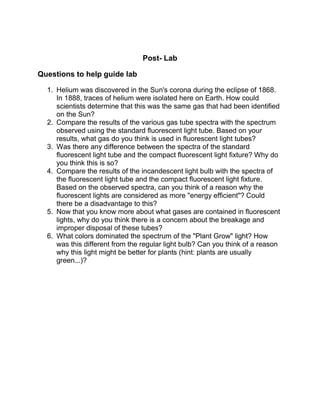Recommended
More Related Content
Viewers also liked
Viewers also liked (10)
Similar to Post lab qs
Similar to Post lab qs (20)
Table of Contents Environmental Science Lab 4 .docx

Table of Contents Environmental Science Lab 4 .docx
Kb on Matter and Chemistry process handouts and notes

Kb on Matter and Chemistry process handouts and notes
Physical and chemical properties and process of matter

Physical and chemical properties and process of matter
Identification of GasesHands-On Labs, Inc. Version 42-01.docx

Identification of GasesHands-On Labs, Inc. Version 42-01.docx
Post lab qs
- 1. Post- Lab Questions to help guide lab 1. Helium was discovered in the Sun's corona during the eclipse of 1868. In 1888, traces of helium were isolated here on Earth. How could scientists determine that this was the same gas that had been identified on the Sun? 2. Compare the results of the various gas tube spectra with the spectrum observed using the standard fluorescent light tube. Based on your results, what gas do you think is used in fluorescent light tubes? 3. Was there any difference between the spectra of the standard fluorescent light tube and the compact fluorescent light fixture? Why do you think this is so? 4. Compare the results of the incandescent light bulb with the spectra of the fluorescent light tube and the compact fluorescent light fixture. Based on the observed spectra, can you think of a reason why the fluorescent lights are considered as more "energy efficient"? Could there be a disadvantage to this? 5. Now that you know more about what gases are contained in fluorescent lights, why do you think there is a concern about the breakage and improper disposal of these tubes? 6. What colors dominated the spectrum of the "Plant Grow" light? How was this different from the regular light bulb? Can you think of a reason why this light might be better for plants (hint: plants are usually green...)?
